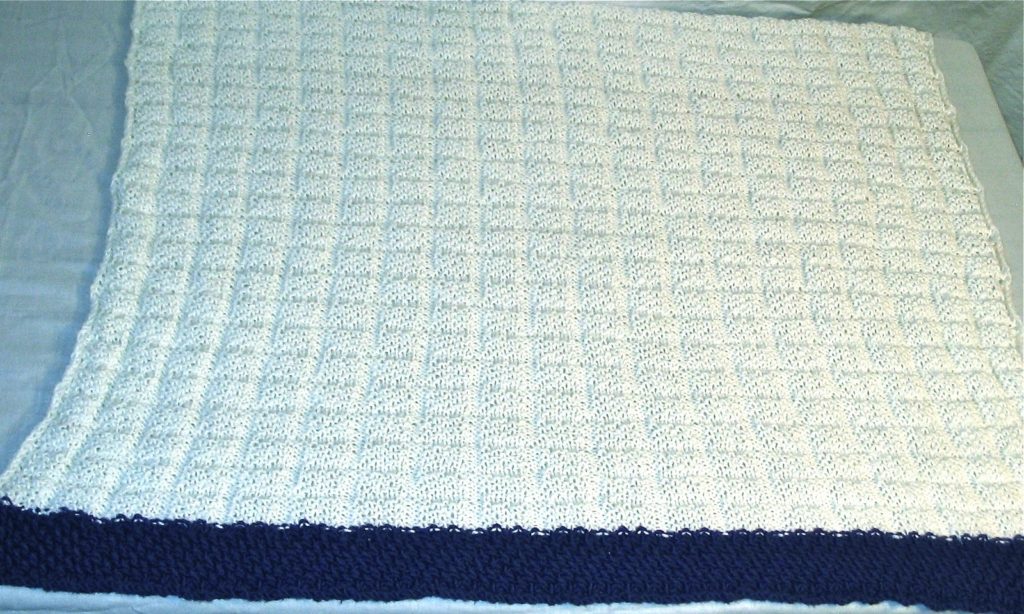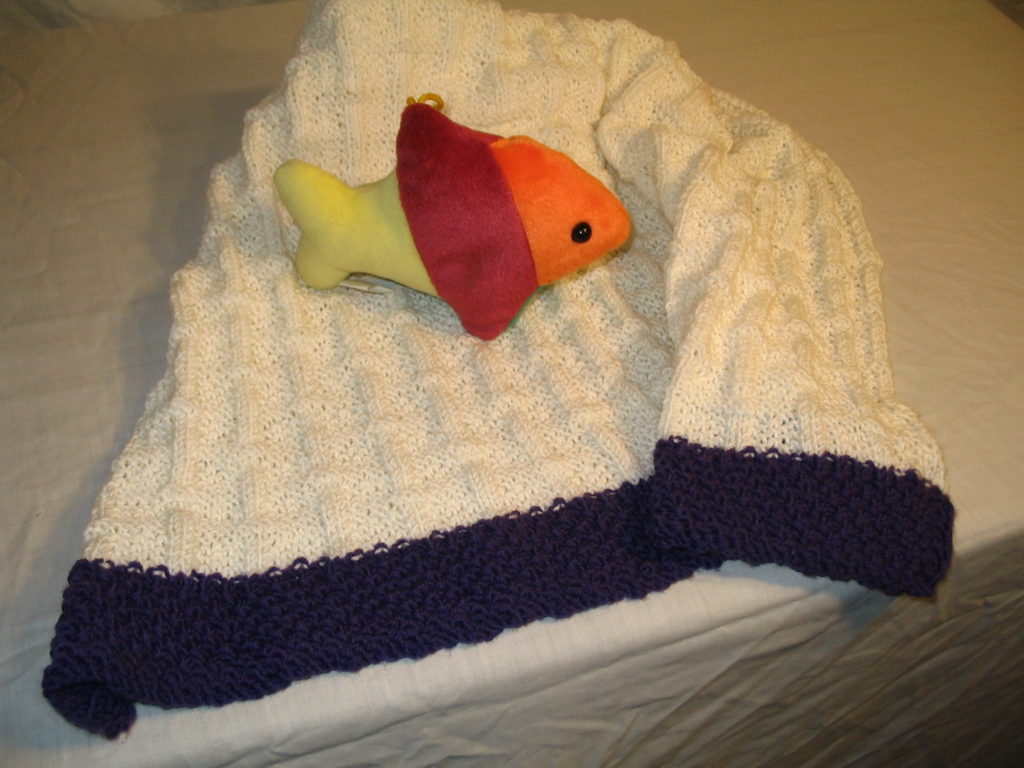This baby blanket carries with it the intention to safeguard a new life. The purple border that marks the beginning of the work symbolized protection in ancient Rome and, when knit with love, might just do the same today. The textured stitch in the body of the blanket is meant to echo the woven fabric prized by the Romans for pure wool togas. The suggested yarn is very soft and machine-washable.

The purple stripe is worked in moss stitch and the body continues in Square Lattice Stitch until the whole piece is 23 inches long. The first and last stitches are knit in such a way as to make a smooth selvedge edge – see Read Before Knitting below.
| Use of color |
| Purple and crimson were royal colors – and expensive because they were arduous to obtain. Indigo – see blue exhibit textile museum. The dye was gained from the glandular fluids of certain types of sea snails in the eastern Mediterranean, known collectively as murex snails. |
Please note: This pattern has not been fully test knit.
Gauge
20 stitches and 5 rows = 4 inches in moss stitch, but gauge is not that important on this project.
Yarn
Debbie Bliss Rialto
100% Merino Superwash 105m/50g
1 ball purple, Color 23016
2 balls white, Color 23001
Needles
US size 6 / 4 mm
Read before knitting
To make a clean edge, or selvedge, when you come to the last stitch of the row, bring the yarn in front of the work, and slip the last stitch without knitting it. Turn. At the beginning of the next row, knit the first stitch through the back loop, using the yarn already hanging at the back of the knitting. This will provide a smooth edge, or selvage.
- With purple, cast on 140 st
- Purl one row
- Knit one row
- Begin Moss Stitch pattern
- Continue in Moss Stitch until the piece measures 2 inches or 5cm from bottom edge to just under the needle.
- End the praetexta section after a RoD 4 and cut the purple, leaving a 4-to-6-inch tail to be woven in with the next row or later
- Picking up the white, begin knitting Square Lattice stitch pattern, maintaining the edge stitches as described above. However, as you start the first row (which is knit), increase 4 stitches evenly across the row – that is, k28 increase 1, knit 28, increase1, and continue. Use an invisible, Make 1 Left (Knitspeak page 115) increase. You should have 144 stitches.
- Continue until the whole piece, measured from the edge of the purple border to just under the needle measures 23 inches.
- Purl the next row
- Knit the next row
- Bind off loosely, using an elastic bind-off as follows: K2tog and place the resulting stitch back on the left-hand needle. K2tog and place that st back on the left-hand needle. Continue knitting two together and slipping the new st back to the left-hand needle until one st is left. Cut yarn, leaving a tail, and draw the tail through the loop, closing gently.
- Weave in ends.
To present as a gift: Steam block lightly by placing the wrap on a towel, sprinkle it with water, lay another towel on top and press a warm iron lightly on top.
Moss Stitch
Row 1: K1, P1 across the row (remember to slip the last st wyf, as described in the note above)
Row 2: Knit the knits and purl the purls (remember to ktbl, as described in the note above) (K1, P1)
Row 3: After the selvage (edge) stitch, do the opposite of what you find: knit the purls and purl the knits (P1, K1)
Row 4: After the selvage stitch, knit the knits and purl the purls (P1, K1)
Square Lattice Stitch
| Row | |
| 1 (RS): | Knit |
| 2 | P2, *K1, P1 twice, K1, P2*, rep from * to * |
| 3 | K3 *P1, K1, P1, K4* repeat from * to *, end last repeat K3 |
| 4 | Same as R2 |
| 5 | Same as R3 |
| 6 | Same as R2 |
| 7 | Same as R3 |
| 8 | P2, *K12, P2*; rep from * to * |
| 9 | K2, *P12, K2*; rep from * to * |
| 10 | Purl |
| 11 | K2, *(P1, K1) twice, P1, K2*, rep from * to * |
| 12 | P3, *K1, P1, K1, P4*; rep from * to *, end last rep P3 |
| 13 | K2, *(P1, K1) twice, P1, K2*, rep from * to * |
| 14 | P3, *K1, P1, K1, P4*; rep from * to *, end last rep P3 |
| 15 | K2, *(P1, K1) twice, P1, K2*, rep from * to * |
| 16 | P3, *K1, P1, K1, P4*; rep from * to *, end last rep P3 |
| 17 | P7, *K2, P12*; rep from *, end K2, P7. |
| 18 | K7, *P2, K12*; rep from *, end P2, K7 |
| 12 | P3, *K1, P1, K1, P4*; rep from * to *, end last rep P3 |
Source: Barbara G. Walker, A Second Treasury of Knitting Patterns (Multiple of 14 st plus 2)

